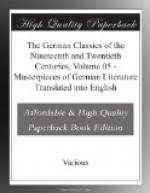Friedrich Rueckert (1788-1866) was prevented from taking part in the Wars of Liberation by poor health, but added his Sonnets in Harness to the poetry of the period. These sonnets had no such stirring effect as the poems of Koerner, not only because of their literary form, but because, in spite of their unquestioned belligerency, they had not the tone of religious conviction against the enemy which characterized the verses of Arndt and the rest. Other poems, like Koerner’s Spirit, show how deeply Rueckert felt himself in sympathy with his times; his reward has been to have added a very large number of poems to the every-day repertory of Germany. His Barbarossa is found in almost every reading book.
The cycle Love’s Spring is an imperishable monument to his love for Louisa Wiethaus. But too many of the poems are dedicated to her and too many inconsequential moods relating to her are recorded. In spite of this, Rueckert has resolved the discord between every-day life and poetry with the simplest poetic apparatus. Rueckert has also enriched the German language with a mass of gnomic poetry, to the writing of which he was led by his Oriental studies. This gnomic poetry (The Wisdom of the Brahman) has been aptly said to recall at times the ripeness of the mature Goethe and at other times—Polonius. Rueckert was one of the first to introduce the Orient and its verse-forms into German literature. Here the influence of Friedrich Schlegel is unmistakable. He was also a master in the reproduction of the complicated metres of the East and South. Though many of these verse-forms have refused to become indigenous in Germany, a large number of new words invented by Rueckert have had poetical vogue, and even where the new formations were too bold or too recherche, they accustomed German ears to a new idea-presentation through sound. Rueckert, like the average Romanticist, lacked moderation in his production, and was utterly without critical faculty in respect to his own verse. Much that he has written has perished, but some of his work—both original and translation—is a permanent part of the best of German lyric verse.
More individual than Rueckert is Adalbert von Chamisso (1781-1838). Though he was born in the Champagne in France, and was therefore a fellow-countryman of Joinville and La Fontaine, he became a German by education and preference, and his name is inseparably linked with German scholarship and letters. It is remarkable that Chamisso began to write German only after 1801 and is reported never to have spoken it perfectly; yet his verse ranks with the best products of Germany in fluency and in form. Much of it, especially that with woman’s love as its theme, is extremely German in thought and feeling, though perhaps French in its keenness of analysis. So German is Chamisso felt to be that at his best he is ranked with Goethe and Heine.




